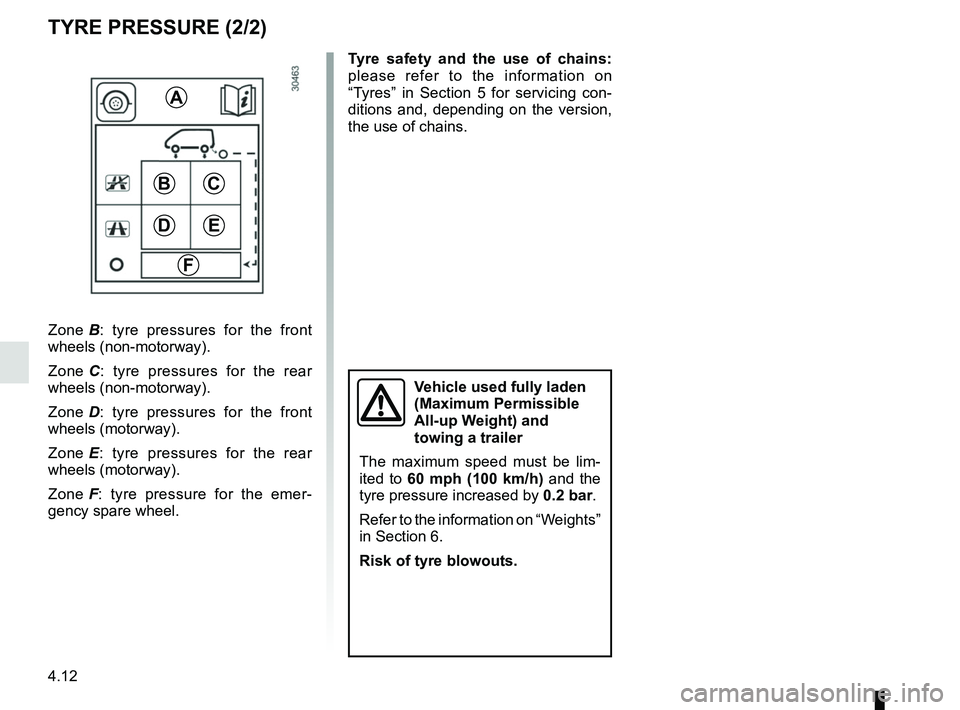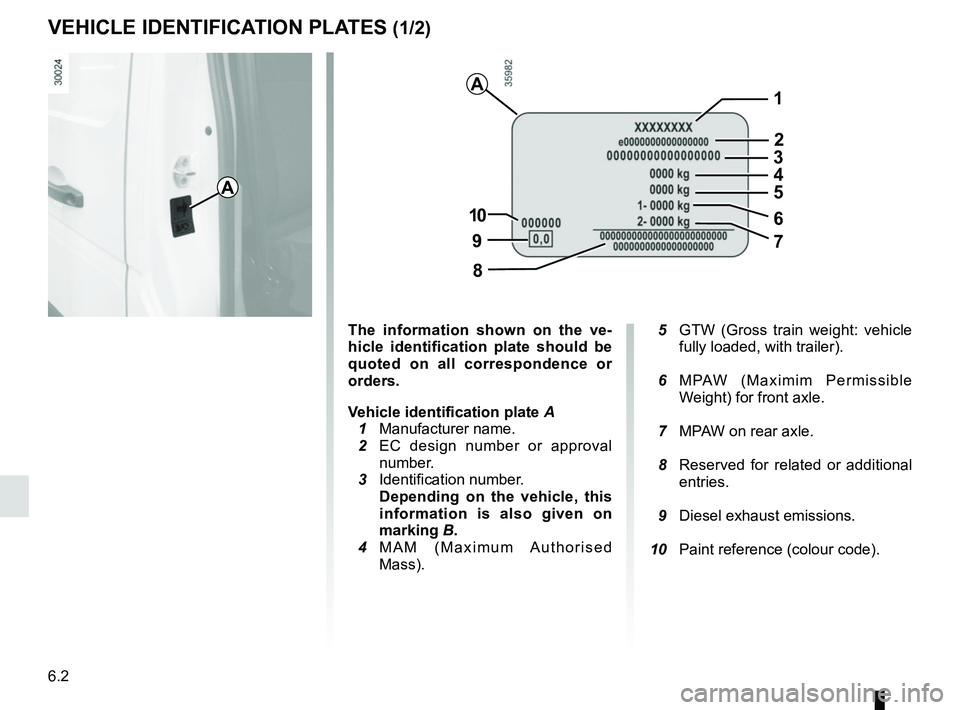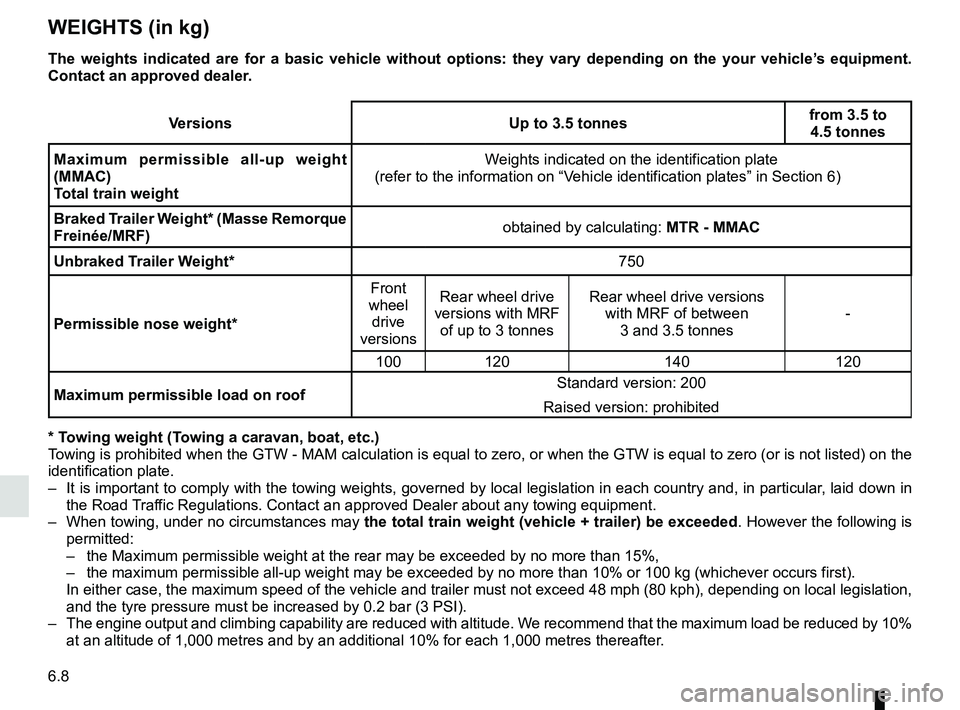2018 RENAULT MASTER weight
[x] Cancel search: weightPage 199 of 290

4.3
BONNET (2/2)
3
4
5
Closing the bonnet
Ensure that the windscreen wiper
blades are correctly positioned.
Place stay 4 back into its holders 5 ,
hold the bonnet in the middle and lower
it to about 20 cm above the closed po-
sition, then release it. It will latch auto-
matically under its own weight.
Ensure that the bonnet is
properly locked.
Check that nothing is pre-
venting the catch from lock-
ing (gravel, cloth, etc.).
Opening the bonnet
Lift the bonnet and release stay 4 from
its holders 5. For your own safety, it is
essential to fix the stay into retainer 3
in the bonnet.
After any procedure in the
engine compartment, make
sure that you do not forget
anything (cloth, tools, etc.).
Otherwise, this may lead to engine
damage or cause a fire.
Page 208 of 290

4.12
BC
ED
F
A
Zone B: tyre pressures for the front
wheels (non-motorway).
Zone C : tyre pressures for the rear
wheels (non-motorway).
Zone D : tyre pressures for the front
wheels (motorway).
Zone E : tyre pressures for the rear
wheels (motorway).
Zone F : tyre pressure for the emer-
gency spare wheel.
TYRE PRESSURE (2/2)
Tyre safety and the use of chains:
please refer to the information on
“Tyres” in Section 5 for servicing con-
ditions and, depending on the version,
the use of chains.
Vehicle used fully laden
(Maximum Permissible
All-up Weight) and
towing a trailer
The maximum speed must be lim-
ited to 60 mph (100 km/h) and the
tyre pressure increased by 0.2 bar.
Refer to the information on “Weights”
in Section 6.
Risk of tyre blowouts.
Page 252 of 290

5.38
TOWING: breakdown (1/2)
The steering wheel must be un-
locked and the ignition key must be
in position M (ignition on) to provide
brake lights and hazard warning
lights on the towed vehicle. At night
the vehicle must have its lights on.
Unhitch the trailer, etc., if one is
being towed.
You must observe the towing regu-
lations which apply in the country in
which you are driving: do not exceed
the towing weight for your vehicle.
Contact an approved dealer.
– Use a rigid towing bar.
If a rope or cable is used
(where the law allows this),
the vehicle being towed
must be able to brake.
– A vehicle must not be towed if it is not fit to be driven.
– Avoid accelerating or braking suddenly when towing, as this
may result in damage being
caused to the vehicle.
– When towing a vehicle, it is ad- visable not to exceed 15 mph
(25 km/h).
When the engine is
stopped, steering and brak-
ing assistance are not op-
erational.
Do not remove the key from
the ignition when the vehi-
cle is being towed.
Towing a vehicle with a
sequential gearbox
If the gearbox is stuck in a gear:
– switch on the ignition;
– select neutral with the brake pedal depressed;
– check that the gearbox is in neutral (by pushing the vehicle for example).
If you cannot find neutral you must tow
the vehicle with the front wheels raised.
The vehicle should always be towed
with the ignition switched off.
Page 261 of 290

6.1
Section 6: Technical specifications
Vehicle identification plates . . . . . . . . . . . . . . . . . . . . . . . . . . . . . . . . . . . . \
. . . . . . . . . . . . . . . . . . . . 6.2
Engine specifications . . . . . . . . . . . . . . . . . . . . . . . . . . . . . . . . . . . . \
. . . . . . . . . . . . . . . . . . . . . . . . . 6.5
Dimensions . . . . . . . . . . . . . . . . . . . . . . . . . . . . . . . . . . . .\
. . . . . . . . . . . . . . . . . . . . . . . . . . . . . . . . 6.6
Weights . . . . . . . . . . . . . . . . . . . . . . . . . . . . . . . . . . . .\
. . . . . . . . . . . . . . . . . . . . . . . . . . . . . . . . . . . 6.8
Replacement parts and repairs . . . . . . . . . . . . . . . . . . . . . . . . . . . . . . . . . . . . \
. . . . . . . . . . . . . . . . . 6.9
Service sheets . . . . . . . . . . . . . . . . . . . . . . . . . . . . . . . . . . . . \
. . . . . . . . . . . . . . . . . . . . . . . . . . . . . . 6.10
Anticorrosion check . . . . . . . . . . . . . . . . . . . . . . . . . . . . . . . . . . . . \
. . . . . . . . . . . . . . . . . . . . . . . . . . 6.16
Page 262 of 290

6.2
VEHICLE IDENTIFICATION PLATES (1/2)
A
A
9
The information shown on the ve-
hicle identification plate should be
quoted on all correspondence or
orders.
Vehicle identification plate A
1 Manufacturer name.
2 EC design number or approval
number.
3 Identification number.
Depending on the vehicle, this
information is also given on
marking B.
4 MAM (Maximum Authorised
Mass).
5 GTW (Gross train weight: vehicle
fully loaded, with trailer).
6 MPAW (Maximim Permissible
Weight) for front axle.
7 MPAW on rear axle.
8 Reserved for related or additional
entries.
9 Diesel exhaust emissions.
10 Paint reference (colour code).
7
8
106
5
4
3
2
1
Page 268 of 290

6.8
WEIGHTS (in kg)
VersionsUp to 3.5 tonnesfrom 3.5 to
4.5 tonnes
Maximum permissible all-up weight
(MMAC)
Total train weight Weights indicated on the identification plate
(refer to the information on “Vehicle identification plates” in Section 6)
Braked Trailer Weight* (Masse Remorque
Freinée/MRF) obtained by calculating:
MTR - MMAC
Unbraked Trailer Weight* 750
Permissible nose weight* Front
wheel drive
versions Rear wheel drive
versions with MRF of up to 3 tonnes Rear wheel drive versions
with MRF of between 3 and 3.5 tonnes -
100 120 140120
Maximum permissible load on roof Standard version: 200
Raised version: prohibited
* Towing weight (Towing a caravan, boat, etc.)
Towing is prohibited when the GTW - MAM calculation is equal to zero, or \
when the GTW is equal to zero (or is not listed) on th e
identification plate.
– It is important to comply with the towing weights, governed by local leg\
islation in each country and, in particular, laid down in the Road Traffic Regulations. Contact an approved Dealer about any towing equipment.
– When towing, under no circumstances may the total train weight (vehicle + trailer) be exceeded . However the following is
permitted:
– the Maximum permissible weight at the rear may be exceeded by no more th\
an 15%,
– the maximum permissible all-up weight may be exceeded by no more than 10\
% or 100 kg (whichever occurs first).
In either case, the maximum speed of the vehicle and trailer must not ex\
ceed 48 mph (80 kph), depending on local legislation, and the tyre pressure must be increased by 0.2 bar (3 PSI).
– The engine output and climbing capability are reduced with altitude. We recommend that the maximum load be reduced by 10% at an altitude of 1,000 metres and by an additional 10% for each 1,000 m\
etres thereafter.
The weights indicated are for a basic vehicle without options: they vary\
depending on the your vehicle’s equipment.
Contact an approved dealer.
Page 286 of 290

7.4
ALPHABETICAL INDEX (4/4)
service sheets........................................................6.10 → 6.15
signals and lights .................................................1.96 → 1.100
speakers location ...............................................................\
......... 5.40
special features of diesel versions....................................... 2.7
speed limiter ..........................................................2.30 → 2.32
starting the engine ............................................................... 2.3
steering wheel adjustment .............................................................\
...... 1.19
Stop & Start ...............................................................2.4 → 2.6
Stop & Start function..................................................2.4 → 2.6
stopping the engine ............................................................. 2.3
storage compartment.............................................3.20 → 3.25
storage compartments ...........................................3.20 → 3.25
sun visor ........................................................................\
.... 3.18
T
tailgate ...............................................................\
................ 3.29
tank AdBlue .........................................................1.104 → 1.109
tanks and reservoirs: windscreen washer ...................................................... 4.10
technical specifications ..............................6.2 – 6.3, 6.6 → 6.9
temperature regulation ........................................... 3.13 – 3.14
tool kit ........................................................................\
.......... 5.4
towing .................................................................\
............... 3.29 driving ................................................................\
.......... 2.18
breakdown ........................................................ 5.38 – 5.39
towing a caravan ............................................................ 6.8
towing hitch........................................................................\
.. 5.4
towing rings ............................................................ 3.29 – 3.30
towing weights ..................................................................... 6.8
traction control .......................................................2.16 → 2.23
transporting children .... 1.33 – 1.34, 1.38 → 1.57, 1.70 → 1.72
transporting objects in the luggage compartment ............................. 3.29 – 3.30 trims ........................................................................\
5.11 – 5.12
trip computer and warning system.......................... 1.84 – 1.85
turning circle ............................................................... 6.6 – 6.7
tyre inflation kit.........................................................5.5
→ 5.10
tyre pressure...................................... 2.24 → 2.26, 4.11 – 4.12
tyre pressure loss warning.....................................2.24 → 2.26
tyre pressures ......................................................... 4.11 – 4.12
tyres ............................. 2.24 → 2.26, 4.11 – 4.12, 5.18 → 5.20
U
unlocking the doors ................................................. 1.8 → 1.11
use in winter ...................................................................... 5.20
V
vehicle identification ................................................... 6.2 – 6.3
vehicle identification plates ......................................... 6.2 – 6.3
ventilation ............................................................... 3.13 – 3.14 air conditioning ...................................................... 3.2 – 3.3
W
warning buzzer ....................................................... 1.13 – 1.14
warning lights.........................................................1.78 → 1.83
washing ................................................................\
.4.14 → 4.16
weights ................................................................\
................ 6.8
wheelbrace .............................................................\
............. 5.4
wheels (safety) ......................................................5.18 → 5.20
windows .................................................................. 3.15 – 3.16
wiper blades ...................................................................... 5.37